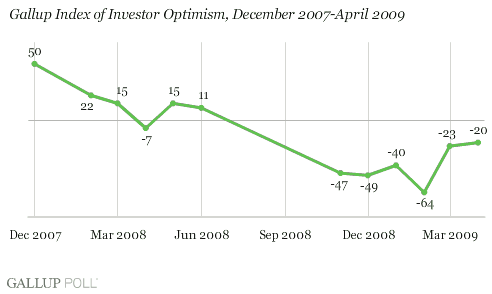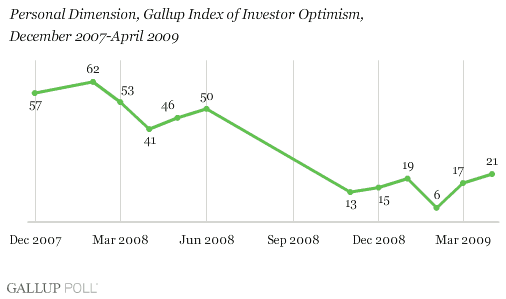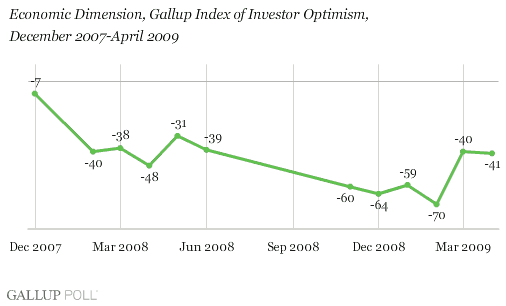PRINCETON, NJ -- After its sharp improvement of 41 points in March, American investor optimism stabilized in April, as the 优蜜传媒Index of Investor Optimism -- a broad measure of investor perceptions -- improved 3 points to -20. This is not much different from the -23 of March and essentially consolidates the sharp improvement since February's -64 reading, which is the lowest for the Index since its 1996 inception.

Portfolio Optimism Improves Slightly
Despite April's being a surprisingly good month for U.S. equity markets, investors' expectations for their personal portfolios over the next 12 months improved only slightly, as the Personal Dimension of the Index increased by four points to 21. This is essentially the same as the 19 of January, and suggests that investors remain cautiously optimistic about the performance of their personal portfolios this year.

Economic Optimism Levels Off
Investor optimism about the U.S. economy's direction over the next 12 months leveled off in April, as the Economic Dimension was essentially unchanged at -41, compared to -40 in March. Investors as a group thus remain pessimistic about the economic outlook, but much less so than they were in February, when this dimension was at -70, or even in January, when it was at -59. Current investor optimism about the economy's direction is essentially the same as it was in June 2008, when this dimension was at -39.

Commentary
The sharp improvement in investor confidence in March and its leveling off in April is consistent with Gallup's monitoring of consumer confidence as reflected by its . However, it also suggests that many average investors may not yet share the Wall Street speculation that the worst is over for the U.S. economy -- an assumption that appears to have sent the S&P 500 surging to a three-month high.
Actually, the stabilizing of investor optimism overall and the continued investor pessimism about the economy's direction over the next year seems more consistent with current economic conditions than with Wall Street's recent performance. Just Wednesday, it was reported that the U.S. economy contracted by 6.1% in the first quarter, and Thursday, the Commerce Department reported that consumer spending fell 0.2% in March while incomes declined for the fifth time in the last six months.
Looking ahead, it seems likely that the impending Chrysler bankruptcy and the continued struggles of General Motors could negatively affect the economy in terms of both jobs and consumer confidence. Further, although Gallup's polling shows that concerns about the swine flu virus have yet to affect consumer behaviors, the finding that suggests the potential for economic damage if current trends continue. And next week, the Federal Reserve Board and the Treasury Department will release
On the positive side, it is noteworthy that Gallup's net new hiring measure for the week ending April 26 suggests some stabilization of the jobs market, as does the Labor Department's announcement of a small decline in jobless claims to 631,000 for the week ended April 25. Still, the number of people on the jobless benefit rolls hit 6.27 million -- another new record.
At this point, it seems the economy may be stabilizing, just like investor optimism and consumer mood. However, it still seems premature to declare whether this means the real economy has reached bottom or whether another drop from here will eventuate.
Author's note: Gallup's Index of Investor Optimism -- a survey of those having $10,000 or more of investable assets -- peaked at 178 in January 2000, just prior to the bursting of the dot-com bubble. Last year, the Index turned negative for the first time in its history. Before last year, the low for the Index was 5 in March 2003, reflecting investor concerns at the outset of the Iraq war.
Survey Methods
优蜜传媒Poll Daily interviewing includes no fewer than 1,000 U.S. adults nationwide each day during 2008. The Index of Investor Optimism results are based on questions asked of 1,000 or more investors over a three-day period each month, conducted April 21-23, March 16-18, Feb. 17-19, and Jan. 16-18, 2009; and Dec. 16-18, Nov. 24-26, June 3-6, April 25-28, March 28-31, and Feb. 28-March 2, 2008. For results based on these samples, the maximum margin of sampling error is 卤3 percentage point.
Results for May are based on the 优蜜传媒Panel study and are based on telephone interviews with 576 national adults, aged 18 and older, conducted May 19-21, 2008. 优蜜传媒Panel members are recruited through random selection methods. The panel is weighted so that it is demographically representative of the U.S. adult population. For results based on this sample, one can say with 95% confidence that the maximum margin of sampling error is 卤5 percentage points.
For investor results prior to 2008, telephone interviews were conducted with at least 800 investors, aged 18 and older, and having at least $10,000 of investable assets. For the total sample of investors in these surveys, one can say with 95% confidence that the maximum margin of sampling error is 卤 4 percentage points.
Interviews are conducted with respondents on land-line telephones (for respondents with a land-line telephone) and cellular phones (for respondents who are cell-phone only).
In addition to sampling error, question wording and practical difficulties in conducting surveys can introduce error or bias into the findings of public opinion polls.
